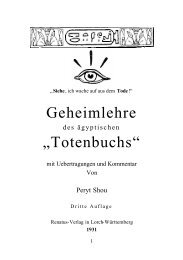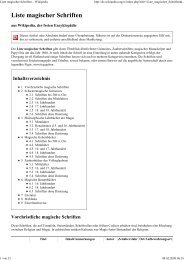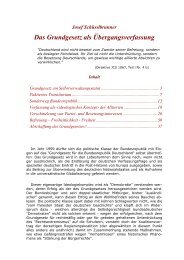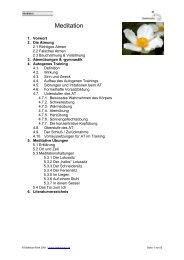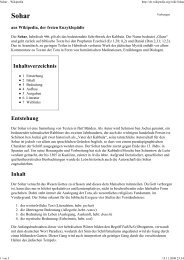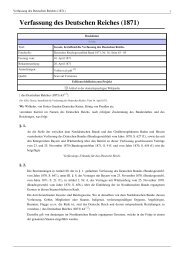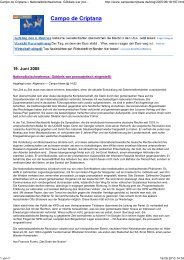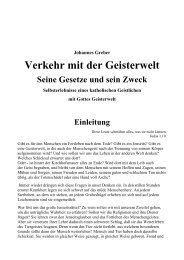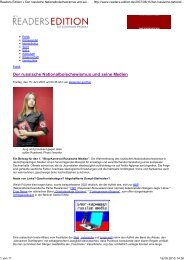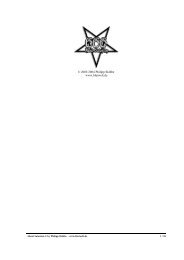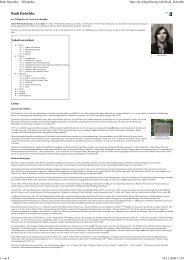Widerstand. Zeitschrift für nationalrevolutionäre Politik - Hexenhort.de
Widerstand. Zeitschrift für nationalrevolutionäre Politik - Hexenhort.de
Widerstand. Zeitschrift für nationalrevolutionäre Politik - Hexenhort.de
You also want an ePaper? Increase the reach of your titles
YUMPU automatically turns print PDFs into web optimized ePapers that Google loves.
<strong>Wi<strong>de</strong>rstand</strong>. <strong>Zeitschrift</strong> für nationalrevolutionäre <strong>Politik</strong> 1<br />
<strong>Wi<strong>de</strong>rstand</strong>. <strong>Zeitschrift</strong> für nationalrevolutionäre<br />
<strong>Politik</strong><br />
Die illustrierte <strong>Zeitschrift</strong> <strong>Wi<strong>de</strong>rstand</strong>. <strong>Zeitschrift</strong> für nationalrevolutionäre <strong>Politik</strong> erschien monatlich von 1926 bis<br />
zu ihrem Verbot im Dezember 1934 im <strong>Wi<strong>de</strong>rstand</strong>s-Verlag, Berlin. Herausgeber waren Ernst Niekisch und A. Paul<br />
Weber.<br />
Geschichte<br />
Ernst Niekisch gilt als einer <strong>de</strong>r Köpfe <strong>de</strong>s Nationalbolschewismus; er trat für eine nationalbolschewistische und<br />
antiwestliche (primär: anti-parlamentarisch-<strong>de</strong>mokratische) <strong>Politik</strong> ein. Er wirkte während <strong>de</strong>r Weimarer Republik<br />
und bis in das „Dritte Reich“ hinein als „Nationalrevolutionär“. 1919 war er Vorsitzen<strong>de</strong>r <strong>de</strong>s Zentralrates <strong>de</strong>r<br />
Arbeiter-, Bauern- und Soldatenräte Bayerns und versuchte in <strong>de</strong>n darauf folgen<strong>de</strong>n Jahren, die Arbeiterschaft für<br />
ihre weltrevolutionäre und zugleich nationale Aufgabe zu bewegen. Damit beeinflusste er <strong>de</strong>n linken Flügel <strong>de</strong>r<br />
Nationalsozialistischen Deutschen Arbeiterpartei (NSDAP) um Gregor Strasser. 1926 grün<strong>de</strong>te er die <strong>Zeitschrift</strong><br />
<strong>Wi<strong>de</strong>rstand</strong>. Blätter für sozialistische und nationalrevolutionäre <strong>Politik</strong>. Sie wur<strong>de</strong> zum Sprachrohr <strong>de</strong>s<br />
Nationalbolschewismus. Gemeinsam mit seiner Frau leitete Niekisch <strong>de</strong>n <strong>Wi<strong>de</strong>rstand</strong>s-Verlag. Ab <strong>de</strong>m Jahrgang<br />
1928 hieß <strong>de</strong>r Untertitel <strong>de</strong>s Blattes <strong>Zeitschrift</strong> für nationalrevolutionäre <strong>Politik</strong>. 1928 begann auch die<br />
Zusammenarbeit mit <strong>de</strong>m Grafiker A. Paul Weber, <strong>de</strong>r für die <strong>Zeitschrift</strong> <strong>Wi<strong>de</strong>rstand</strong> politisch-satirische<br />
Porträt-Karikaturen, satirisch-allegorische Tierdarstellungen und Zeichnungen entwarf. Zu <strong>de</strong>n bekanntesten zählt<br />
die Lithographie Das Gerücht.<br />
Zu <strong>de</strong>n Mitarbeitern gehörten u. a. die Schriftsteller Ernst Jünger, Friedrich Georg Jünger, Joseph E. Drexel, Gustav<br />
Son<strong>de</strong>rmann, <strong>de</strong>r frühere Funktionär <strong>de</strong>s All<strong>de</strong>utschen Verban<strong>de</strong>s, H. Armstrong, Hans Bäcker, Ro<strong>de</strong>rich von<br />
Bistram, Friedrich Gregorius, Wilfried Knöpke, Otto Nickel, Otto Petras, Spektator, Eugen Schmahl (womöglich<br />
zum Teil Pseudonyme) und Ernst von Salomon. Joseph E. Drexel, <strong>de</strong>r spätere Herausgeber <strong>de</strong>r Nürnberger<br />
Nachrichten, berichtet in einer autobiographischen Skizze:<br />
„Im Jahre 1925 war ich Ernst Niekisch begegnet, eine Begegnung, die sich für meinen weiteren<br />
Lebensweg als entschei<strong>de</strong>nd erweisen sollte. Niekisch war in seiner kompromißlosen Radikalität <strong>de</strong>s<br />
Denkens, in seiner persönlichen Integrität, in seiner Fähigkeit, Menschen <strong>de</strong>r verschie<strong>de</strong>nsten und<br />
gegensätzlichsten politischen Überzeugungen anzuziehen, eine respektheischen<strong>de</strong> Persönlichkeit. Zu<br />
seinen Freun<strong>de</strong>n und Mitarbeitern zählten ebenso Sozialisten linker und linkester Provenienz wie große<br />
Konservative. Mit diesem ungewöhnlichen Mann verband mich alsbald eine enge, niemals zur blin<strong>de</strong>n<br />
Jüngerschaft entarten<strong>de</strong> Freundschaft, die über vierzig Jahre und über bittere Erlebnisse hinweg bis zum<br />
To<strong>de</strong> Niekischs nichts an Herzlichkeit und Aufrichtigkeit verlor. Die Anschauungen Ernst Niekischs<br />
fan<strong>de</strong>n über viele Jahre hinweg ihren Nie<strong>de</strong>rschlag in <strong>de</strong>r von ihm herausgegebenen <strong>Zeitschrift</strong> ‚Der<br />
<strong>Wi<strong>de</strong>rstand</strong>’, zu <strong>de</strong>ssen Mitarbeitern ich bis zum Verbot <strong>de</strong>r <strong>Zeitschrift</strong> zählte.“<br />
Über diese <strong>Zeitschrift</strong> schrieb Paul Sethe in <strong>de</strong>r ‚Welt‘ (1958):<br />
„Wie soll man heute jungen Menschen begreiflich machen, was <strong>de</strong>r Name Ernst Niekisch uns einmal<br />
be<strong>de</strong>utet hatte. Diese schmalen Hefte mit <strong>de</strong>m Titel ‚<strong>Wi<strong>de</strong>rstand</strong>’, <strong>de</strong>r wie eine Fanfare klang, mit <strong>de</strong>n<br />
drei schroffen Zacken auf <strong>de</strong>m Umschlagbild, die Sinnbild waren für inneres Aufbegehren; diese<br />
Thesen, die man in vielen erregten Gesprächen ebenso lei<strong>de</strong>nschaftlich bestritten wie verteidigt hörte.<br />
Bis sich schließlich das große Schweigen <strong>de</strong>r Zuchthauszelle über diesen furchtlosen Mann senkte.<br />
Diesen furchtlosen Mann, <strong>de</strong>r die Zuchthauszelle gelähmt und erblin<strong>de</strong>t verließ, nannte freilich kürzlich<br />
in einer Rundfunksendung einer meiner Münchner Kollegen von <strong>de</strong>r Süd<strong>de</strong>utschen Zeitung, <strong>de</strong>r sich<br />
selber vermutlich für einen politischen Kopf ersten Ranges hält: ‚einen <strong>de</strong>utschnationalen Lyriker und<br />
schwanken<strong>de</strong>n Halbpolitiker’ (ich zitiere aus <strong>de</strong>m Kopf). Hier kann sogar die Trauer über eine solche
<strong>Wi<strong>de</strong>rstand</strong>. <strong>Zeitschrift</strong> für nationalrevolutionäre <strong>Politik</strong> 2<br />
Entgleisung noch etwas Erheitern<strong>de</strong>s haben. Aber ‚Wenige sind wert, daß man ihnen wi<strong>de</strong>rspricht’.’“<br />
Siehe auch<br />
• Nationaler <strong>Wi<strong>de</strong>rstand</strong><br />
Literatur<br />
• Ernst Niekisch (Hrsg.): Schriften <strong>de</strong>s „<strong>Wi<strong>de</strong>rstand</strong>“. Dres<strong>de</strong>n [Struvestr. 7 III]: <strong>Wi<strong>de</strong>rstand</strong>s-Verlag Anna Niekisch<br />
• Helmuth von Moltke: Die westliche Grenzfrage. Mit einer Einleitung von Ernst Niekisch und <strong>de</strong>m Signet <strong>de</strong>s<br />
<strong>Wi<strong>de</strong>rstand</strong>sverlages von A. Paul Weber. Dres<strong>de</strong>n: <strong>Wi<strong>de</strong>rstand</strong>s-Verlag Anna Niekisch: 1929, XV, 58 S.<br />
(Schriften <strong>de</strong>s „<strong>Wi<strong>de</strong>rstand</strong>“, Hrsg. Ernst Niekisch, Band 1)<br />
• Ernst Niekisch: <strong>Politik</strong> und I<strong>de</strong>e [Erweiterung eines Vortrages]. Buchausstattung von A. Paul Weber, Dres<strong>de</strong>n:<br />
<strong>Wi<strong>de</strong>rstand</strong>s-Verlag Anna Niekisch, 1929, 74 S. (Schriften <strong>de</strong>s „<strong>Wi<strong>de</strong>rstand</strong>“, Hrsg. Ernst Niekisch; Band 2)<br />
• Ernst Niekisch (Hrsg.): <strong>Wi<strong>de</strong>rstand</strong>. Blätter für sozialistische und nationalrevolutionäre <strong>Politik</strong>.<br />
<strong>Wi<strong>de</strong>rstand</strong>s-Verlag<br />
• Ernst Niekisch: <strong>Wi<strong>de</strong>rstand</strong> [ausgewählte Aufsätze aus „<strong>Wi<strong>de</strong>rstand</strong> - Blätter für sozialistische und<br />
nationalrevolutionäre <strong>Politik</strong>“]. Mit Zeichnungen von A. Paul Weber. [Hrsg. und eingeleitet von Uwe Sauermann.<br />
Hrsg. in Zusammenarbeit mit <strong>de</strong>m Verein zur För<strong>de</strong>rung Kultur- und Sozialwissenschaftlicher Publizistik und<br />
Bildung e.V.]. Krefeld: Sinus-Verlag, 1982, 212 S., ISBN 3-88289-203-X (Edition d; Band 3)<br />
• Ernst Niekisch und A. Paul Weber (Hrsg.): <strong>Wi<strong>de</strong>rstand</strong>. <strong>Zeitschrift</strong> für nationalrevolutionäre <strong>Politik</strong>,<br />
<strong>Wi<strong>de</strong>rstand</strong>s-Verlag, Berlin (Der 9. Jahrgang 1934 erschien noch, dann Verbot im Dezember 1934)<br />
• Ernst Niekisch (Hrsg.): Entscheidung. Die Wochenzeitung für nationalrevolutionäre <strong>Politik</strong>. Berlin:<br />
<strong>Wi<strong>de</strong>rstand</strong>s-Verlag (Erscheinungsverlauf: Nr. 1: 9. Oktober 1932 bis Nr. 11: 26. März 1933; damit Erscheinen<br />
eingestellt)<br />
• Joseph E. Drexel: Geschichte und Geschichten - Ein Leben in Franken. Vortrag: Bayerischer Rundfunk, Studio<br />
Nürnberg, 27. März 1969. Nürnberg: Verlag Nürnberger Presse, 1969, Privatdruck; 38 S.; hier: S. 16 f.<br />
• Uwe Sauermann: Ernst Niekisch. Zwischen allen Fronten. Mit einem bio-bibliographischen Anhang von Armin<br />
Mohler. München, Berlin: Herbig, 1980, 236 S., ISBN 3-7766-1013-1 (Herbig aktuell) (Bibliographie E. Niekisch<br />
S. 219 – 236)<br />
• Uwe Sauermann: Die <strong>Zeitschrift</strong> „<strong>Wi<strong>de</strong>rstand</strong>“ und ihr Kreis. Die publizistische Entwicklung eines Organs <strong>de</strong>s<br />
extremen Nationalismus und sein Wirkungsbereich in die politische Kultur Deutschlands 1926-1934. Universität<br />
Augsburg, Philos. Fak., Diss. A, 1984, vorgelegt von Uwe Sauermann. 1984, V, 459 S. - München:<br />
Bibliotheksdienst Angerer, ²1985, V, 458 S., ISBN 3-922128-15-7<br />
• Birgit Rätsch-Langejürgen: Das Prinzip <strong>Wi<strong>de</strong>rstand</strong>. Leben und Wirken von Ernst Niekisch. Zugleich:<br />
Dissertation Universität München, 1994/95. Bonn: Bouvier, 1997, 392 S., ISBN 3-416-02608-X (Schriftenreihe<br />
Extremismus & Demokratie; Bd. 7)
Quellen und Bearbeiter <strong>de</strong>r Artikel 3<br />
Quellen und Bearbeiter <strong>de</strong>r Artikel<br />
<strong>Wi<strong>de</strong>rstand</strong>. <strong>Zeitschrift</strong> für nationalrevolutionäre <strong>Politik</strong> Quelle: http://<strong>de</strong>.wikipedia.org/w/in<strong>de</strong>x.php?oldid=74082254 Bearbeiter: Arno Matthias, Asthma, Cholo Aleman, Dinah, Duloce,<br />
Hao Xi, Jürgen Oetting, Lefanu, Liondancer, Nopoco, Saltose, Sowie, €pa, 7 anonyme Bearbeitungen<br />
Lizenz<br />
Wichtiger Hinweis zu <strong>de</strong>n Lizenzen<br />
Die nachfolgen<strong>de</strong>n Lizenzen bezieht sich auf <strong>de</strong>n Artikeltext. Im Artikel gezeigte Bil<strong>de</strong>r und Grafiken können unter einer an<strong>de</strong>ren Lizenz stehen sowie von Autoren erstellt wor<strong>de</strong>n sein, die nicht in <strong>de</strong>r Autorenliste<br />
erscheinen. Durch eine noch vorhan<strong>de</strong>ne technische Einschränkung wer<strong>de</strong>n die Lizenzinformationen für Bil<strong>de</strong>r und Grafiken daher nicht angezeigt. An <strong>de</strong>r Behebung dieser Einschränkung wird gearbeitet.<br />
Das PDF ist daher nur für <strong>de</strong>n privaten Gebrauch bestimmt. Eine Weiterverbreitung kann eine Urheberrechtsverletzung be<strong>de</strong>uten.<br />
Creative Commons Attribution-ShareAlike 3.0 Unported - Deed<br />
Diese "Commons Deed" ist lediglich eine vereinfachte Zusammenfassung <strong>de</strong>s rechtsverbindlichen Lizenzvertrages (http:/ / <strong>de</strong>. wikipedia. org/ wiki/ Wikipedia:Lizenzbestimmungen_Commons_Attribution-ShareAlike_3. 0_Unported)<br />
in allgemeinverständlicher Sprache.<br />
Sie dürfen:<br />
• das Werk bzw. <strong>de</strong>n Inhalt vervielfältigen, verbreiten und öffentlich zugänglich machen<br />
• Abwandlungen und Bearbeitungen <strong>de</strong>s Werkes bzw. Inhaltes anfertigen<br />
Zu <strong>de</strong>n folgen<strong>de</strong>n Bedingungen:<br />
• Namensnennung — Sie müssen <strong>de</strong>n Namen <strong>de</strong>s Autors/Rechteinhabers in <strong>de</strong>r von ihm festgelegten Weise nennen.<br />
• Weitergabe unter gleichen Bedingungen — Wenn Sie das lizenzierte Werk bzw. <strong>de</strong>n lizenzierten Inhalt bearbeiten, abwan<strong>de</strong>ln o<strong>de</strong>r in an<strong>de</strong>rer Weise erkennbar als Grundlage für eigenes Schaffen verwen<strong>de</strong>n, dürfen Sie die<br />
daraufhin neu entstan<strong>de</strong>nen Werke bzw. Inhalte nur unter Verwendung von Lizenzbedingungen weitergeben, die mit <strong>de</strong>nen dieses Lizenzvertrages i<strong>de</strong>ntisch, vergleichbar o<strong>de</strong>r kompatibel sind.<br />
Wobei gilt:<br />
• Verzichtserklärung — Je<strong>de</strong> <strong>de</strong>r vorgenannten Bedingungen kann aufgehoben wer<strong>de</strong>n, sofern Sie die ausdrückliche Einwilligung <strong>de</strong>s Rechteinhabers dazu erhalten.<br />
• Sonstige Rechte — Die Lizenz hat keinerlei Einfluss auf die folgen<strong>de</strong>n Rechte:<br />
• Die gesetzlichen Schranken <strong>de</strong>s Urheberrechts und sonstigen Befugnisse zur privaten Nutzung;<br />
• Das Urheberpersönlichkeitsrecht <strong>de</strong>s Rechteinhabers;<br />
• Rechte an<strong>de</strong>rer Personen, entwe<strong>de</strong>r am Lizenzgegenstand selber o<strong>de</strong>r bezüglich seiner Verwendung, zum Beispiel Persönlichkeitsrechte abgebil<strong>de</strong>ter Personen.<br />
• Hinweis — Im Falle einer Verbreitung müssen Sie an<strong>de</strong>ren alle Lizenzbedingungen mitteilen, die für dieses Werk gelten. Am einfachsten ist es, an entsprechen<strong>de</strong>r Stelle einen Link auf http:/ / creativecommons. org/ licenses/<br />
by-sa/ 3. 0/ <strong>de</strong>ed. <strong>de</strong> einzubin<strong>de</strong>n.<br />
Haftungsbeschränkung<br />
Die „Commons Deed“ ist kein Lizenzvertrag. Sie ist lediglich ein Referenztext, <strong>de</strong>r <strong>de</strong>n zugrun<strong>de</strong>liegen<strong>de</strong>n Lizenzvertrag übersichtlich und in allgemeinverständlicher Sprache, aber auch stark vereinfacht wie<strong>de</strong>rgibt. Die Deed selbst<br />
entfaltet keine juristische Wirkung und erscheint im eigentlichen Lizenzvertrag nicht.<br />
GNU Free Documentation License<br />
Version 1.2, November 2002<br />
Copyright (C) 2000,2001,2002 Free Software Foundation, Inc.<br />
51 Franklin St, Fifth Floor, Boston, MA 02110-1301 USA<br />
Everyone is permitted to copy and distribute verbatim copies<br />
of this license document, but changing it is not allowed.<br />
0. PREAMBLE<br />
The purpose of this License is to make a manual, textbook, or other functional and useful document "free" in the sense of freedom: to assure everyone the effective freedom to copy and redistribute it, with or without modifying it,<br />
either commercially or noncommercially. Secondarily, this License preserves for the author and publisher a way to get credit for their work, while not being consi<strong>de</strong>red responsible for modifications ma<strong>de</strong> by others.<br />
This License is a kind of "copyleft", which means that <strong>de</strong>rivative works of the document must themselves be free in the same sense. It complements the GNU General Public License, which is a copyleft license <strong>de</strong>signed for free<br />
software.<br />
We have <strong>de</strong>signed this License in or<strong>de</strong>r to use it for manuals for free software, because free software needs free documentation: a free program should come with manuals providing the same freedoms that the software does. But this<br />
License is not limited to software manuals; it can be used for any textual work, regardless of subject matter or whether it is published as a printed book. We recommend this License principally for works whose purpose is instruction or<br />
reference.<br />
1. APPLICABILITY AND DEFINITIONS<br />
This License applies to any manual or other work, in any medium, that contains a notice placed by the copyright hol<strong>de</strong>r saying it can be distributed un<strong>de</strong>r the terms of this License. Such a notice grants a world-wi<strong>de</strong>, royalty-free<br />
license, unlimited in duration, to use that work un<strong>de</strong>r the conditions stated herein. The "Document", below, refers to any such manual or work. Any member of the public is a licensee, and is addressed as "you". You accept the license<br />
if you copy, modify or distribute the work in a way requiring permission un<strong>de</strong>r copyright law.<br />
A "Modified Version" of the Document means any work containing the Document or a portion of it, either copied verbatim, or with modifications and/or translated into another language.<br />
A "Secondary Section" is a named appendix or a front-matter section of the Document that <strong>de</strong>als exclusively with the relationship of the publishers or authors of the Document to the Document's overall subject (or to related matters)<br />
and contains nothing that could fall directly within that overall subject. (Thus, if the Document is in part a textbook of mathematics, a Secondary Section may not explain any mathematics.) The relationship could be a matter of<br />
historical connection with the subject or with related matters, or of legal, commercial, philosophical, ethical or political position regarding them.<br />
The "Invariant Sections" are certain Secondary Sections whose titles are <strong>de</strong>signated, as being those of Invariant Sections, in the notice that says that the Document is released un<strong>de</strong>r this License. If a section does not fit the above<br />
<strong>de</strong>finition of Secondary then it is not allowed to be <strong>de</strong>signated as Invariant. The Document may contain zero Invariant Sections. If the Document does not i<strong>de</strong>ntify any Invariant Sections then there are none.<br />
The "Cover Texts" are certain short passages of text that are listed, as Front-Cover Texts or Back-Cover Texts, in the notice that says that the Document is released un<strong>de</strong>r this License. A Front-Cover Text may be at most 5 words, and a<br />
Back-Cover Text may be at most 25 words.<br />
A "Transparent" copy of the Document means a machine-readable copy, represented in a format whose specification is available to the general public, that is suitable for revising the document straightforwardly with generic text editors<br />
or (for images composed of pixels) generic paint programs or (for drawings) some wi<strong>de</strong>ly available drawing editor, and that is suitable for input to text formatters or for automatic translation to a variety of formats suitable for input to<br />
text formatters. A copy ma<strong>de</strong> in an otherwise Transparent file format whose markup, or absence of markup, has been arranged to thwart or discourage subsequent modification by rea<strong>de</strong>rs is not Transparent. An image format is not<br />
Transparent if used for any substantial amount of text. A copy that is not "Transparent" is called "Opaque".<br />
Examples of suitable formats for Transparent copies inclu<strong>de</strong> plain ASCII without markup, Texinfo input format, LaTeX input format, SGML or XML using a publicly available DTD, and standard-conforming simple HTML,<br />
PostScript or PDF <strong>de</strong>signed for human modification. Examples of transparent image formats inclu<strong>de</strong> PNG, XCF and JPG. Opaque formats inclu<strong>de</strong> proprietary formats that can be read and edited only by proprietary word processors,<br />
SGML or XML for which the DTD and/or processing tools are not generally available, and the machine-generated HTML, PostScript or PDF produced by some word processors for output purposes only.<br />
The "Title Page" means, for a printed book, the title page itself, plus such following pages as are nee<strong>de</strong>d to hold, legibly, the material this License requires to appear in the title page. For works in formats which do not have any title<br />
page as such, "Title Page" means the text near the most prominent appearance of the work's title, preceding the beginning of the body of the text.<br />
A section "Entitled XYZ" means a named subunit of the Document whose title either is precisely XYZ or contains XYZ in parentheses following text that translates XYZ in another language. (Here XYZ stands for a specific section<br />
name mentioned below, such as "Acknowledgements", "Dedications", "Endorsements", or "History".) To "Preserve the Title" of such a section when you modify the Document means that it remains a section "Entitled XYZ" according<br />
to this <strong>de</strong>finition.<br />
The Document may inclu<strong>de</strong> Warranty Disclaimers next to the notice which states that this License applies to the Document. These Warranty Disclaimers are consi<strong>de</strong>red to be inclu<strong>de</strong>d by reference in this License, but only as regards<br />
disclaiming warranties: any other implication that these Warranty Disclaimers may have is void and has no effect on the meaning of this License.<br />
2. VERBATIM COPYING<br />
You may copy and distribute the Document in any medium, either commercially or noncommercially, provi<strong>de</strong>d that this License, the copyright notices, and the license notice saying this License applies to the Document are reproduced<br />
in all copies, and that you add no other conditions whatsoever to those of this License. You may not use technical measures to obstruct or control the reading or further copying of the copies you make or distribute. However, you may<br />
accept compensation in exchange for copies. If you distribute a large enough number of copies you must also follow the conditions in section 3.<br />
You may also lend copies, un<strong>de</strong>r the same conditions stated above, and you may publicly display copies.<br />
3. COPYING IN QUANTITY<br />
If you publish printed copies (or copies in media that commonly have printed covers) of the Document, numbering more than 100, and the Document's license notice requires Cover Texts, you must enclose the copies in covers that<br />
carry, clearly and legibly, all these Cover Texts: Front-Cover Texts on the front cover, and Back-Cover Texts on the back cover. Both covers must also clearly and legibly i<strong>de</strong>ntify you as the publisher of these copies. The front cover<br />
must present the full title with all words of the title equally prominent and visible. You may add other material on the covers in addition. Copying with changes limited to the covers, as long as they preserve the title of the Document<br />
and satisfy these conditions, can be treated as verbatim copying in other respects.<br />
If the required texts for either cover are too voluminous to fit legibly, you should put the first ones listed (as many as fit reasonably) on the actual cover, and continue the rest onto adjacent pages.<br />
If you publish or distribute Opaque copies of the Document numbering more than 100, you must either inclu<strong>de</strong> a machine-readable Transparent copy along with each Opaque copy, or state in or with each Opaque copy a<br />
computer-network location from which the general network-using public has access to download using public-standard network protocols a complete Transparent copy of the Document, free of ad<strong>de</strong>d material. If you use the latter<br />
option, you must take reasonably pru<strong>de</strong>nt steps, when you begin distribution of Opaque copies in quantity, to ensure that this Transparent copy will remain thus accessible at the stated location until at least one year after the last time<br />
you distribute an Opaque copy (directly or through your agents or retailers) of that edition to the public.<br />
It is requested, but not required, that you contact the authors of the Document well before redistributing any large number of copies, to give them a chance to provi<strong>de</strong> you with an updated version of the Document.<br />
4. MODIFICATIONS<br />
You may copy and distribute a Modified Version of the Document un<strong>de</strong>r the conditions of sections 2 and 3 above, provi<strong>de</strong>d that you release the Modified Version un<strong>de</strong>r precisely this License, with the Modified Version filling the role<br />
of the Document, thus licensing distribution and modification of the Modified Version to whoever possesses a copy of it. In addition, you must do these things in the Modified Version:<br />
• A. Use in the Title Page (and on the covers, if any) a title distinct from that of the Document, and from those of previous versions (which should, if there were any, be listed in the History section of the Document). You may use<br />
the same title as a previous version if the original publisher of that version gives permission.<br />
• B. List on the Title Page, as authors, one or more persons or entities responsible for authorship of the modifications in the Modified Version, together with at least five of the principal authors of the Document (all of its principal<br />
authors, if it has fewer than five), unless they release you from this requirement.<br />
• C. State on the Title page the name of the publisher of the Modified Version, as the publisher.<br />
• D. Preserve all the copyright notices of the Document.<br />
• E. Add an appropriate copyright notice for your modifications adjacent to the other copyright notices.<br />
• F. Inclu<strong>de</strong>, immediately after the copyright notices, a license notice giving the public permission to use the Modified Version un<strong>de</strong>r the terms of this License, in the form shown in the Ad<strong>de</strong>ndum below.<br />
• G. Preserve in that license notice the full lists of Invariant Sections and required Cover Texts given in the Document's license notice.<br />
• H. Inclu<strong>de</strong> an unaltered copy of this License.<br />
• I. Preserve the section Entitled "History", Preserve its Title, and add to it an item stating at least the title, year, new authors, and publisher of the Modified Version as given on the Title Page. If there is no section Entitled<br />
"History" in the Document, create one stating the title, year, authors, and publisher of the Document as given on its Title Page, then add an item <strong>de</strong>scribing the Modified Version as stated in the previous sentence.<br />
• J. Preserve the network location, if any, given in the Document for public access to a Transparent copy of the Document, and likewise the network locations given in the Document for previous versions it was based on. These<br />
may be placed in the "History" section. You may omit a network location for a work that was published at least four years before the Document itself, or if the original publisher of the version it refers to gives permission.<br />
• K. For any section Entitled "Acknowledgements" or "Dedications", Preserve the Title of the section, and preserve in the section all the substance and tone of each of the contributor acknowledgements and/or <strong>de</strong>dications given<br />
therein.<br />
• L. Preserve all the Invariant Sections of the Document, unaltered in their text and in their titles. Section numbers or the equivalent are not consi<strong>de</strong>red part of the section titles.<br />
• M. Delete any section Entitled "Endorsements". Such a section may not be inclu<strong>de</strong>d in the Modified Version.<br />
• N. Do not retitle any existing section to be Entitled "Endorsements" or to conflict in title with any Invariant Section.<br />
• O. Preserve any Warranty Disclaimers.
Lizenz 4<br />
If the Modified Version inclu<strong>de</strong>s new front-matter sections or appendices that qualify as Secondary Sections and contain no material copied from the Document, you may at your option <strong>de</strong>signate some or all of these sections as<br />
invariant. To do this, add their titles to the list of Invariant Sections in the Modified Version's license notice. These titles must be distinct from any other section titles.<br />
You may add a section Entitled "Endorsements", provi<strong>de</strong>d it contains nothing but endorsements of your Modified Version by various parties--for example, statements of peer review or that the text has been approved by an organization<br />
as the authoritative <strong>de</strong>finition of a standard.<br />
You may add a passage of up to five words as a Front-Cover Text, and a passage of up to 25 words as a Back-Cover Text, to the end of the list of Cover Texts in the Modified Version. Only one passage of Front-Cover Text and one of<br />
Back-Cover Text may be ad<strong>de</strong>d by (or through arrangements ma<strong>de</strong> by) any one entity. If the Document already inclu<strong>de</strong>s a cover text for the same cover, previously ad<strong>de</strong>d by you or by arrangement ma<strong>de</strong> by the same entity you are<br />
acting on behalf of, you may not add another; but you may replace the old one, on explicit permission from the previous publisher that ad<strong>de</strong>d the old one.<br />
The author(s) and publisher(s) of the Document do not by this License give permission to use their names for publicity for or to assert or imply endorsement of any Modified Version.<br />
5. COMBINING DOCUMENTS<br />
You may combine the Document with other documents released un<strong>de</strong>r this License, un<strong>de</strong>r the terms <strong>de</strong>fined in section 4 above for modified versions, provi<strong>de</strong>d that you inclu<strong>de</strong> in the combination all of the Invariant Sections of all of<br />
the original documents, unmodified, and list them all as Invariant Sections of your combined work in its license notice, and that you preserve all their Warranty Disclaimers.<br />
The combined work need only contain one copy of this License, and multiple i<strong>de</strong>ntical Invariant Sections may be replaced with a single copy. If there are multiple Invariant Sections with the same name but different contents, make the<br />
title of each such section unique by adding at the end of it, in parentheses, the name of the original author or publisher of that section if known, or else a unique number. Make the same adjustment to the section titles in the list of<br />
Invariant Sections in the license notice of the combined work.<br />
In the combination, you must combine any sections Entitled "History" in the various original documents, forming one section Entitled "History"; likewise combine any sections Entitled "Acknowledgements", and any sections Entitled<br />
"Dedications". You must <strong>de</strong>lete all sections Entitled "Endorsements".<br />
6. COLLECTIONS OF DOCUMENTS<br />
You may make a collection consisting of the Document and other documents released un<strong>de</strong>r this License, and replace the individual copies of this License in the various documents with a single copy that is inclu<strong>de</strong>d in the collection,<br />
provi<strong>de</strong>d that you follow the rules of this License for verbatim copying of each of the documents in all other respects.<br />
You may extract a single document from such a collection, and distribute it individually un<strong>de</strong>r this License, provi<strong>de</strong>d you insert a copy of this License into the extracted document, and follow this License in all other respects regarding<br />
verbatim copying of that document.<br />
7. AGGREGATION WITH INDEPENDENT WORKS<br />
A compilation of the Document or its <strong>de</strong>rivatives with other separate and in<strong>de</strong>pen<strong>de</strong>nt documents or works, in or on a volume of a storage or distribution medium, is called an "aggregate" if the copyright resulting from the compilation<br />
is not used to limit the legal rights of the compilation's users beyond what the individual works permit. When the Document is inclu<strong>de</strong>d in an aggregate, this License does not apply to the other works in the aggregate which are not<br />
themselves <strong>de</strong>rivative works of the Document.<br />
If the Cover Text requirement of section 3 is applicable to these copies of the Document, then if the Document is less than one half of the entire aggregate, the Document's Cover Texts may be placed on covers that bracket the<br />
Document within the aggregate, or the electronic equivalent of covers if the Document is in electronic form. Otherwise they must appear on printed covers that bracket the whole aggregate.<br />
8. TRANSLATION<br />
Translation is consi<strong>de</strong>red a kind of modification, so you may distribute translations of the Document un<strong>de</strong>r the terms of section 4. Replacing Invariant Sections with translations requires special permission from their copyright hol<strong>de</strong>rs,<br />
but you may inclu<strong>de</strong> translations of some or all Invariant Sections in addition to the original versions of these Invariant Sections. You may inclu<strong>de</strong> a translation of this License, and all the license notices in the Document, and any<br />
Warranty Disclaimers, provi<strong>de</strong>d that you also inclu<strong>de</strong> the original English version of this License and the original versions of those notices and disclaimers. In case of a disagreement between the translation and the original version of<br />
this License or a notice or disclaimer, the original version will prevail.<br />
If a section in the Document is Entitled "Acknowledgements", "Dedications", or "History", the requirement (section 4) to Preserve its Title (section 1) will typically require changing the actual title.<br />
9. TERMINATION<br />
You may not copy, modify, sublicense, or distribute the Document except as expressly provi<strong>de</strong>d for un<strong>de</strong>r this License. Any other attempt to copy, modify, sublicense or distribute the Document is void, and will automatically terminate<br />
your rights un<strong>de</strong>r this License. However, parties who have received copies, or rights, from you un<strong>de</strong>r this License will not have their licenses terminated so long as such parties remain in full compliance.<br />
10. FUTURE REVISIONS OF THIS LICENSE<br />
The Free Software Foundation may publish new, revised versions of the GNU Free Documentation License from time to time. Such new versions will be similar in spirit to the present version, but may differ in <strong>de</strong>tail to address new<br />
problems or concerns. See http:/ / www. gnu. org/ copyleft/ .<br />
Each version of the License is given a distinguishing version number. If the Document specifies that a particular numbered version of this License "or any later version" applies to it, you have the option of following the terms and<br />
conditions either of that specified version or of any later version that has been published (not as a draft) by the Free Software Foundation. If the Document does not specify a version number of this License, you may choose any version<br />
ever published (not as a draft) by the Free Software Foundation.<br />
ADDENDUM: How to use this License for your documents<br />
To use this License in a document you have written, inclu<strong>de</strong> a copy of the License in the document and put the following copyright and license notices just after the title page:<br />
Copyright (c) YEAR YOUR NAME.<br />
Permission is granted to copy, distribute and/or modify this document<br />
un<strong>de</strong>r the terms of the GNU Free Documentation License, Version 1.2<br />
or any later version published by the Free Software Foundation;<br />
with no Invariant Sections, no Front-Cover Texts, and no Back-Cover Texts.<br />
A copy of the license is inclu<strong>de</strong>d in the section entitled<br />
"GNU Free Documentation License".<br />
If you have Invariant Sections, Front-Cover Texts and Back-Cover Texts, replace the "with...Texts." line with this:<br />
with the Invariant Sections being LIST THEIR TITLES, with the<br />
Front-Cover Texts being LIST, and with the Back-Cover Texts being LIST.<br />
If you have Invariant Sections without Cover Texts, or some other combination of the three, merge those two alternatives to suit the situation.<br />
If your document contains nontrivial examples of program co<strong>de</strong>, we recommend releasing these examples in parallel un<strong>de</strong>r your choice of free software license, such as the GNU General Public License, to permit their use in free<br />
software.



